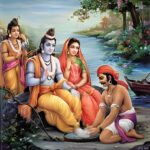Khatu Shyam Ji, one of the most revered deities in hinduism, holds a significant place in the spiritual landscape of India. Worshiped primarily in the northern states, Khatu Shyam Ji is believed to be an incarnation of BARBARIKA, the grandson of BHIMA (one of the pandavas from mahabharata) and HIDIMBA. His story is deeply connected with the epic mahabharata and reflects themes of devotion, sacrifice and the triumph of righteousness.
The history of BARABARIKA

Barabarika, also known as shyam baba, was the son of GHATOTKACH and MAURVI. From a very young age, Barabarika exhibited extraordinary skills in warfare and archery. His devotion to Lord Krishna and adherence to dharma made him an exceptional warrior.
Barabarika possessed three divine arrows, granted by the gods as a boon. These arrows were so powerful that:-
- The first arrow could mark all the targets he intend to destroy.
- The second arrow could mark everything he wished to save.
- The third arrow, when released, would destroy all the marked targets, sparing the marked ones.
This unique ability, earned him the title of TEEN BAAN DHARI( bearer of three arrows).
Barabarika’s promise and Krishna’s test

Before the great kurukshetra war, Barabarika pledged to support the weaker side in the battle. As news of his unmatched prowess spread, Lord Krishna, the guide and the charioteers of the Pandavas, became concerned. Krishna, aware of the devastating potential of the BARABARIKA’S arrows, decided to test him.
Disguised as a Brahmin, Krishna approached Barbarika and asked him about his role in the impending war. Barbarika reiterated his vow to support the weaker side. Krishna realized that this vow could lead to a perpetual cycle, as Barbarika’s intervention would continuously shift the balance of power. If he fought for the weaker side, his overwhelming strength would tip the scales, making the opposing side weaker, and so on.
To prevent this paradox and to safeguard dharma, Krishna revealed his true identity and sought Barbarika’s head as a sacrifice. Without hesitation, Barbarika offered his head, fulfilling his ultimate dharma of selflessness.
The Grant of Eternal Fame
Moved by Barbarika’s sacrifice and devotion, Lord Krishna granted him a boon. Barbarika’s severed head was placed atop a hill to witness the entire Kurukshetra War. Krishna promised that Barbarika would be worshiped in Kaliyuga under the name Shyam. Devotees believe that invoking Khatu Shyam Ji with a pure heart fulfills all wishes, especially those made selflessly.
The Discovery of the Idol
The idol of Khatu Shyam Ji was unearthed in the village of Khatu in the Sikar district of Rajasthan. The legend states that the idol was discovered buried in the sands after a series of divine visions guided the local villagers. Eventually, a temple was built at the site, which today stands as a major pilgrimage center.
The temple, built by Roop Singh Chauhan and his wife Narmada Kanwar in the 18th century, showcases exquisite Rajasthani architecture. Over time, it has been renovated and expanded to accommodate the growing number of devotees.
Significance of the Temple

The Khatu Shyam Ji Temple is an epicenter of spiritual energy and devotion. The temple complex includes a sanctum sanctorum where the idol of Khatu Shyam Ji, adorned with a crown and garlands, is enshrined. Devotees visit the temple throughout the year, but the most significant event is the Phalgun Mela, held annually in February or March. During this festival, thousands of devotees gather to celebrate and pay homage.
Another important ritual associated with the temple is the Jalabhishek, where devotees offer water and flowers to the deity. Many also participate in the Akhanda Jyoti, a continuous flame that burns as a symbol of eternal devotion.
Worship and Beliefs
Khatu Shyam Ji is known as the God of the Kaliyuga. It is believed that he listens to the prayers of his devotees and provides relief from their sufferings. His worship emphasizes simplicity and faith. Devotees often chant the mantra “Haare Ka Sahara, Khatu Shyam Hamara” (Khatu Shyam is the refuge of the defeated) to seek his blessings during times of distress.
One of the unique aspects of Khatu Shyam Ji’s worship is the offering of sheera (sweet pudding) and churma (a traditional sweet). These offerings are distributed as prasad among the devotees.
Pilgrimage and Festivals
The pilgrimage to Khatu Shyam Ji Temple is considered a spiritual journey that cleanses the soul. The Phalgun Mela marks the largest gathering, where devotees often undertake a padayatra (foot journey) from nearby towns and villages. The temple remains open around the clock during this period, with elaborate ceremonies and cultural performances.
Apart from the Phalgun Mela, devotees also observe Ekadashi (the eleventh day of the lunar fortnight) with special prayers and offerings.
The Message of Khatu Shyam Ji
Khatu Shyam Ji’s legend conveys timeless values:
- Selflessness: Barbarika’s willingness to sacrifice his life for the greater good reflects the highest form of altruism.
- Faith and Devotion: His unwavering faith in Krishna symbolizes the importance of surrendering to divine will.
- Support for the Weak: By vowing to assist the weaker side, Barbarika embodies compassion and justice.
These virtues inspire millions of followers to lead a life of righteousness and humility.
Conclusion
The history of Khatu Shyam Ji is a testament to the enduring power of devotion, sacrifice, and divine grace. From his origins in the Mahabharata to the bustling temple in Rajasthan, Khatu Shyam Ji continues to guide and bless his devotees. His story serves as a beacon of hope, reminding everyone that faith and selflessness can overcome any challenge.
ALSO VISIT- 9 most important jagran rituals



Pingback: Kevat prasang: enthralling episode from the Ramayana in 1000 words